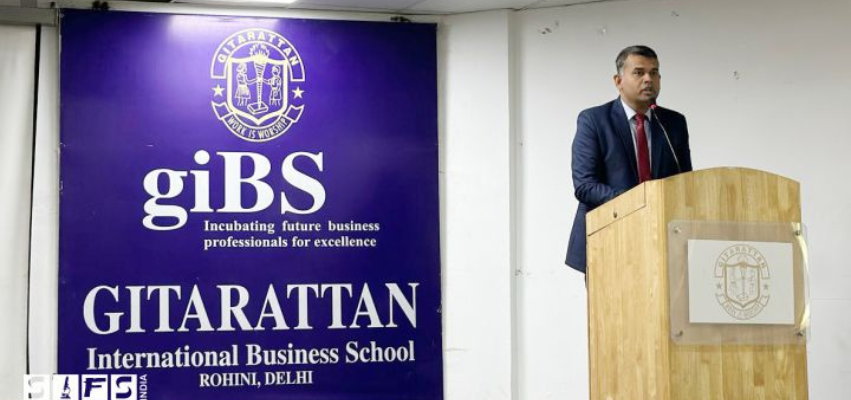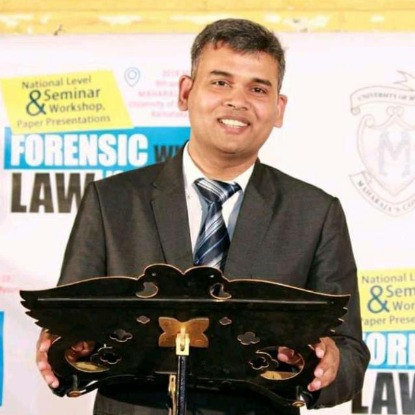On the morning of April 11, 2025, I had the pleasure of addressing an enthusiastic group of B.A.LL.B and B.B.A.LL.B 6th semester students at Gitarattan International Business School.
The session was titled “Enhancing India’s Digital Forensic Capabilities: Adopting International Standards with BNS, BSA, and BNSS”, and I must say, the engagement from the students and faculty was truly inspiring.
As someone who has been deeply involved in the fields of digital forensics and law for many years, I’ve observed both the strengths and the gaps in India’s current framework for handling cybercrime and electronic evidence.
This lecture was my opportunity to not only share knowledge but to also encourage future legal professionals to embrace the evolving landscape of cyber law and digital investigations.
Why Digital Forensics Matters More Than Ever?
We live in an era where digital evidence is often more critical than physical evidence. From emails and mobile phone logs to CCTV footage and social media posts, digital traces have become a cornerstone in both civil and criminal investigations. Yet, despite this growing reliance, our legal and investigative frameworks still have a lot of catching up to do—especially when it comes to standardization and admissibility of digital evidence.
The increasing complexity of cybercrimes—ranging from online frauds and data breaches to cyber terrorism—requires not just technical tools but a strong legal backbone. That’s where the BNS (Bharatiya Nyaya Sanhita), BSA (Bharatiya Suraksha Adhiniyam), and BNSS (Bharatiya Nagrik Suraksha Sanhita) come into play.
What I Shared with the Students?
In the lecture, I began by giving a quick overview of the evolution of cyber forensics in India.
From rudimentary data recovery methods in the early 2000s to today’s sophisticated tools for analyzing cloud storage, encrypted devices, and blockchain transactions, the journey has been remarkable. But tools alone aren't enough.
A robust legal framework is equally important to ensure that digital evidence is collected, preserved, and presented in a manner that upholds the rule of law.
Introducing BNS, BSA, and BNSS
Many students were unfamiliar with the depth and scope of the new criminal law reforms: the Bharatiya Nyaya Sanhita (BNS), Bharatiya Suraksha Adhiniyam (BSA), and Bharatiya Nagrik Suraksha Sanhita (BNSS), which aim to replace the outdated IPC, CrPC, and Indian Evidence Act.
I emphasized that these reforms offer a historic opportunity to integrate international best practices in handling digital evidence. Here are a few key points I discussed:
BNS: Introduces clearer provisions related to cyber offences, categorizing them based on severity and intent. It brings clarity to crimes like identity theft, online harassment, and digital impersonation.
BSA: Focuses on the protection of national security, which is increasingly intertwined with cybersecurity. This includes the legal framework around surveillance, encryption, and protection of critical digital infrastructure.
BNSS: Perhaps the most important for our discussion—it deals with the procedures related to evidence collection and admissibility. I spoke about how BNSS needs to adapt to the challenges of chain-of-custody in digital forensics, data volatility, and the authentication of electronic records.
Bridging the Gap Between Technology and Law
One of the core messages I shared was this: law and technology can no longer exist in silos. Legal professionals of tomorrow must be comfortable discussing terms like hash values, metadata, digital signatures, and log file analysis. Similarly, forensic experts must understand the legal requirements for evidence admissibility.
We discussed several real-life case studies where poor handling of digital evidence led to cases being dismissed or delayed. These examples drove home the point that knowledge of international standards—like ISO/IEC 27037 (guidelines for digital evidence handling)—is not optional anymore. It's essential.
Global Best Practices: A Must for India
I also touched upon the need for India to benchmark its digital forensic capabilities against global standards. Countries like the United States, the UK, and Germany have developed clear protocols for forensic investigations and courtroom procedures involving electronic evidence.
To adopt such standards, we need:
Trained manpower: Lawyers, judges, and police officials must undergo specialized training in cyber laws and digital forensics.
Certified labs: We need more digital forensic labs accredited by global bodies like ISO or NABL, which follow standardized evidence-handling procedures.
Legal reforms: BNS, BSA, and BNSS are a start, but they must be complemented by sector-specific cyber laws and privacy regulations.
Students: The Future Force of Change
What truly impressed me was the curiosity and sharp questions posed by the students. Some asked about the conflict between privacy and surveillance. Others inquired about the role of artificial intelligence in crime detection. A few were genuinely interested in pursuing careers in digital forensics or cyber law.
I reminded them that they are entering the legal profession at a pivotal time. The boundaries between physical and digital crimes are blurring, and future-ready lawyers must be digital natives who understand not just statutes, but also how a line of code can become critical evidence in court.
Final Thoughts
As I concluded the session, I left the students with a challenge: to not view digital forensics as a niche area, but as an integral part of modern legal practice.
Whether they become corporate lawyers, public prosecutors, judges, or legal advisors, understanding digital evidence will give them a competitive edge and make them more effective professionals.
I’m grateful to Gitarattan International Business School for inviting me and for recognizing the importance of blending legal education with technological awareness. The future of justice in India depends on how well we prepare today’s students for tomorrow’s challenges—and I’m hopeful that we are on the right path.


